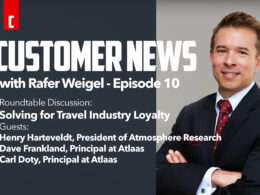SPECIAL EDITION
What is it about some business that seem to transcend the “normal” trajectory of growth and end up far ahead of the curve – well beyond their competitors? In this special edition of Customerland, author and Wall Street Journal cartoonist, Stu Heinecke looks at the data, the trends, the processes and the people who are making things happen … in spite of their circumstances.
Stu’s latest book, “How to Grow Your Business Like a Weed” comes on the heels of his best-selling book “How to Get a Meeting with Anyone: The Untapped Selling Power of Contact Marketing” which has been named one of the most important business books of the past decade.

Full Transcript Below
Mike Giambattista:
We’ll talk about your book books shortly, but you’ve got quite a background. I’ve seen something of your cv. It’s, it’s not what I would call linear <laugh>
Stu Heinecke:
<Laugh>,
Mike Giambattista:
But that probably has contributed to, to your perspective on life and business. And, you know, maybe just tell us about a little bit where, where you came from and how you got to this point.
Stu Heinecke:
Yeah. Well, I mean
From a business standpoint, the where I came from is I went to USC, got a marketing degree, and I wanted to but I was also a cartoonist already. I was already published in the LA papers. And I, I wanted to mix the two. I wanted to mix cartooning and, and personalization had just become a f a factor and, and, and put it into direct mail campaigns. But I wanted to do it for these very, very glamorous clients. These, all these magazine publishers. They were some of the biggest, most sophisticated users and testers of, of direct response. And so I wanted to, wanted to set it up there. There was a problem though, David Ogilvy, do you remember him? I know, sure. You know, we’re, we’re old enough to remember him. So David used to say that, that he was the, for those who don’t know, he was the original thought leader, I would say, in marketing and advertising.
And so he used to say that people don’t buy from clowns that humor doesn’t work in, in marketing and advertising. So all of his followers would say the same thing. Let’s say for example, up on stage when they’re giving a, a talk about how to succeed in, in in direct mail. Well, so I had that headwind, but here’s, here’s what pushed me through. I knew that readership se surveys were saying that cartoons were almost always the best way to remember parts of magazines and newspapers. And I just thought, well, that’s, that’s it. I mean, that it’s such a, there’s such a powerful device. I’m just gonna go ahead anyway. And so that led to all kinds of crazy things in my life. One was I got my first two assignments, Rolling Stone and Bon Apetit. And so I created what
Mike Giambattista:
Not bad first gigs.
Stu Heinecke:
Not bad. So I created these test campaigns for them, and they, they went up against their controls, their, their, their most, the most effective thing they’d ever mailed in those positions in their campaigns. And, and the, the two first pieces I did beat their controls, that was like a rookie walking onto, well, we’re talking about the, probably the Red Sox, right? But walking onto the baseball, walking onto Fenway Park and hitting two grand Slam home runs. And so from that came a bunch of things. One is that I, I thought, okay, that’s my opening. I will reach out to the rest of the publishing industry to really, if I, I needed to reach out to about maybe two dozen people. And these were VPs of circulation or consumer marketing at, you know, companies like Time Inc. And Conde Nast and the Wall Street Journal, and so Forbes and so on.
So just about 24 of ’em. And I just thought, I, no, I don’t know how I’m gonna reach out to them, but I, I wanna send them a, a sample of a personalized cartoon. And then I’m just gonna send them a note with that, that says, Hey, this is, this is a device. I just used to beat the controls for Rolling Stone and Bonna Petit, and I think we should put these to the test for your titles. And and I, that thing changed my life. I mean, that, that launched, I got through to all of them. Not only that, but all of them agreed to meet and all of them became clients. So it was a hundred percent response. Wow. And conversion, sorry, a hundred percent response, meeting rate, and then conversion. And, and it, it was worth millions of dollars to launch my business.
And it all came from a campaign that went to 24 people. It cost me about a hundred dollars. And so that led to writing how to Grow, I’m sorry, how to get a meeting with anyone eventually. But also during that time cartooning was a big feature of, of what I was doing. And so I, I thought, well, okay, I, it launched my, my agency and I need to offer more than just my cartooning. I need to offer, you know, other, I I want to bring in my favorite cartoonists into my group. And so I recruited, again, I don’t know if you’ll remember these names, but Gahan Wilson and Eldon Dini from Playboy. And then and then a bunch of New Yorker cartoonists. And so Bob Mankoff and Arne Levin and Leo Cullum and all these great, these were my heroes of cartooning.
And they would, you know, we, I would work with them so much on these campaigns and I’d go out to New York, cause most of them were, were in New York in New York City and hang out with them. And, and really, I ended up being mentored by these, by these cartoonists <laugh>. I didn’t realize nobody realized that was happening. But, but that’s what happened, that, that was one of those outcomes as well. And then I mentioned the, the, the book or my first book, how, how to how to get a meeting with anyone opt out of that. And, and my whole career started with creating direct mail campaigns for publishers.
Mike Giambattista:
That’s wild. I guess if all 24 of your outreach prospects responded, it was a hundred percent response rate, you almost have to write a book at that point, because that’s, no, that’s, that’s miraculous
Stu Heinecke:
Kind of, except that all I thought I, at that point, I just thought, but that was, that was weird. <Laugh>. You know, what just happened, <laugh>. And then and then I thought, you know, I got, how far can I go with this? I, and I started sending cartoons to presidents and prime ministers and celebrities and, and just a lot of mischief actually with the cartoons, but, and lots of sea level folks. And I was getting through and I thought, well, man, aren’t I cool? I’ve got a secret weapon. And and then I realized, wait a minute, that how silly of me, because look, everyone has to get meetings. Everyone has to deal with this issue of, well, how do you break through to these people who can change everything in, in your career and just change the scale of what you’re doing?
How do you, how’s, what’s everyone else doing? And that was what that focus outward is, what what really helped and changed everything, because then I started coming across all these crazy stories of what people were doing to get meetings. And, and you know, I, I got that a hundred percent response rate right off the bat. I mentioned I couldn’t talk about that at all because if I had, again, David Ogilvy was probably the, the gen, the progenitor of this. But, but the, the experts also used to say that a hundred percent response rates were absolutely impossible. Indirect response. They probably are indirect response. But, but this wasn’t direct response. I don’t know what to call it, you know? So, but, but it wasn’t quite direct response. And so I, I couldn’t talk about the fact that I sent that campaign out and got a hundred percent response rate.
But once I started talking to some of these other people who had these interesting methods for breaking through, like let’s say Dan Walsh Schmidt, who sends swords, he has these swords made up for these CEOs of companies that are in trouble. He, he runs a, a, a a turnaround consultancy. And so, you know, he, he, hey, when he, when he finds someone who’s, who’s has a story of missed earnings estimates in the news, he has a sword made up by the prop maker who made all the swords to the movie Gladiator. And he sends it out in this beautiful felt lined wooden box. And a, a handwritten note. There’s no branding on it. I mean, there’s no logos or anything, just a handwritten note from Dan to you, the c e o of who or whoever he is writing to. And, and he’s saying, Hey, listen businesses war, and I noticed you lost a battle recently. Just wanted to let you know if you ever need a few e extra hands in battle, we’ve got your back. And that was the whole point of sending the sword. And, and he was getting a hundred percent response rate. And okay, others were getting these, and actually one got, one was getting something somewhere between three and 400% response to to his contact campaign
Sponsor Message
Each year. For the past 20 years or so, the world’s best marketers have been gathering in Chicago for two and a half days of high level learning and networking. It’s called CRMC on my calendar. I’ve placed a hard hold on June 7th through the ninth so that I can be there and be a part of what’s about to happen in retail, in loyalty and in technology. You should be there too. You can learn more, and you can register in the link below this podcast, or you can go directly to the event [email protected]. That’s THECRMC.com.
Stu Heinecke:
We’re talking about how to grow your business like a weed. And, and so that book, I just need to explain real quickly that that book came from a long time ago. I was driving down the Santa Monica freeway, and it could have been any freeway anywhere, but I, it was the Santa Monica Freeway in LA and there are six lanes of traffic coming one way, six coming the other way. It’s all concrete and roaring tires. And then there’s a 40 foot, I think it’s about 40 feet wide median in the middle. It’s all concrete though. And I noticed a dandelion going from a crack in the concrete median. And, and that is something we see all the time. We’re seeing it all the time, right? They’re all out right now. So we’re seeing right now it, and, and, but this particular time as I drove by, I just thought, well, look at that.
You know, it looks happy. It looks, you know, those happy yellow flowers and the seed pods, and it’s bouncing around and the smoggy turbulence of the, the cars going by. And I just thought, it looks really happy running its process, just making a living from a crack. Didn’t care that it ended up in a crack in the middle of the freeway. I mean, it wasn’t saying to itself probably, well, this sucks. I saw myself as living at the beach. You know, something like that. It didn’t let anything like that get in the way. And I just thought, you know, that’s remarkable because we don’t see, I don’t pick any other plants. We don’t see oak trees or pine trees or, or rose bushes or petunias growing out of cracks in the concrete of anything. It’s just weeds. And so it got me thinking as I whiz by, what is it about weeds that are so special?
What, how are they doing this? Do they have a model that they all use? Like it’s some sort of a unified model? And, and if they do, is it applicable to our businesses? And I, I just resolved at that point to I just wanted to take that lesson or take, take in a lot more lessons from weeds and understand what it is they’re doing to survive and thrive in places and under and under conditions that the rest of us would wilt under. I mean, other plants don’t show up there, so what is it about them? And I realized that they came to realize that they all follow this one this one formula for, for growth. And it, I think it’s not just, it’s not only a you know, formula for business, I would say it’s just, it’s sort of a theory of everything about growing anything.
And, and so when I, when, as I, so this has been ruminating as a book idea for quite a long time. And and then you mentioned Kathy Ireland and General Barry McCaffrey, and I also interviewed David Petraeus, who also forced our general and the former director of the c i A and a c i a station chief. I was trying to understand, I thought there we’d, they kind of live in a weed like world, so sure. I wanted to really understand the essence of how the same, the same strategies that weeds use show up in business and help us grow. And so, and, and just sort of in human life, <laugh>. So that’s, that’s why we ended up with, with really a pretty disparate group of people. But I also interviewed a lot of business experts, startup experts, et cetera, just all kinds of, well, and also botanists and weed scientists.
Didn’t know there were any <laugh> until, until writing the book, but weed scientists. And I really just wanted to get an idea of what is it that weeds are doing, and how has that shown up in, let’s say, the lives of Kathy Ireland. And you know, Kathy is just, she’s a I don’t think she’s quite a billionaire, but she’s quite, quite well off. We, of course, we knew her from being a suit sorry, a, an SI or sports Illustrated model and, and then being just a high fashion model. But she realized at some point that she, she’s gonna be an old model. And I, I think Paulina pos Cova talks about this a lot, that she, she says, you know, I can’t get dates and which seems really odd to me, <laugh>, yeah, right. But okay, that’s, I don’t know why Paulina, but I’m sure you’ll get ’em <laugh>.
So but but she was sitting with her team one day in their kitchen, in her kitchen saying, what am I gonna do? I need to reinvent myself. And, and so what can I do? What, what, what are my, essentially, what are my unfair advantages, which is part of the weeds model. I mean, the weeds, weeds leverage a fierce mindset, an expansive, fierce, aggressive mindset, even though they don’t have brains, but they do. You can see it in your garden and in your yard. They leverage that and unfair advantages against collective scale. And they do it according to a process that has been honed over millions of years, but it’s able to adapt almost instantly to any challenge. So that’s, that’s their model. That’s how they do it. And so Kathy was asking her team, what are my unfair advantages that I can take into, into the next chapter of my life?
And of course, she was well known and she was able to, to parlay that into, I really, she’s a branding empire at this point. And she told me though, that she always thought of herself as a weed <laugh>. That was no kidding <laugh>. And you know, so she, I you could say that her career grew like a weed and then, and then eventually her business grew like a weed. And, and it did it through a lot of, I mean, I think that the two characteristics that really stand out to me, and they stand out to me as, as things that will be that we’ll be talking about and, and these missions that will serve with with the people that show up to our our growth summits, we, that we’re setting up all over the world.
And so I think, so these, these would be just a small group of entrepreneurs who are there to, to, to apply the weed strategy model to their, to their business to help them grow that. One of the things that’s really interesting about weeds is that they thrive in disrupted ground. I mean, they thrive best in disrupted ground. That’s, in other words, our yards, our gardens, farms, and so forth. I mean, they live for that. That’s, I dunno if they live for that, let’s just say though that their, their methods, everything about it, their model, their methods, their tools, all helps them thrive in, in ground that has just been disrupted. So ground that has, that has just scattered all the other plants away. That’s where they thrive best. And I think that that says a lot about using weed strategy to thrive during other dis well disruptions in our lives.
And we’re always going through disruptions. We’re in one now. We were in, we just came out of one, the, a big one, the pandemic, but now we’re in a, at least a slowdown, if not a recession. So it’s just a constant thing. A AI will be another huge disruption. So how do we deal with all that? And I think that we deal with that in some pretty simple ways. We develop unfair advantages for ourselves. These are advantages that they’re not really unfair advantages. They’re not illegal. It’s just things that, that we, that we can bring to market that help us compete. So our competitors might think of them as unfair advantages. And, and then the other is that weeds are natural collaborators. And so it’s, it’s all about developing these unfair advantages and collaborations. And collaborations are just, they’re magical.












